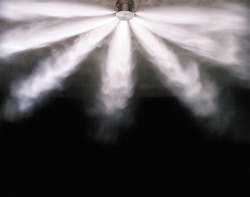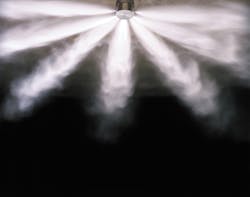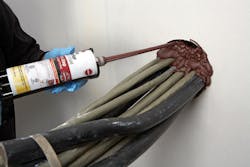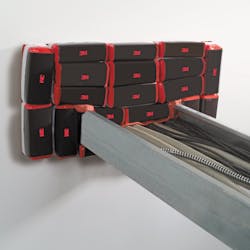How to control fire in the data center
From the November, 2014 Issue of Cabling Installation & Maintenance Magazine
Prevention, detection, suppression and containment combine to make up a holistic approach to this disastrous circumstance.
by Kim Griger, 3M Data Center Markets
Common challenges with data center management range from reducing costs to lowering environmental impact. But one important issue should not be overlooked: fire management. A fire in the data center could threaten not only the safety of the managing personnel, but also the building and equipment. Repairing or replacing these long-term assets can be financially detrimental to a company.
Outside of the physical assets, the system downtime can also be costly and lengthy based on the types of extinguishing materials used and the severity of the fire. In fact, recent study results indicate the average cost of data center downtime per hour is $163,674 (Source: Aberdeen Group, "Downtime and Data Loss: How Much Can You Afford?"). This cost to the business has increased by approximately 18 percent in the past year, according to the same Aberdeen Group study.
Several recent high-profile data center fires have been reported around the world. In October 2013, a fire at the U.S. National Security Association (NSA) data center storage facility in Utah destroyed equipment and delayed the facility's opening (Source: The Fiscal Times, "$2 Billion NSA Spy Center is Going Up in Flames," October 2013). Storage and information management firm Iron Mountain experienced a fire at their facility in Buenos Aires, Argentina in February 2014. In addition to the damage to the building and lost information, several first responders were killed trying to extinguish the fire (Source: Technology Advice, "Fire Destroys Iron Mountain Data Warehouse in Buenos Aires," February 2014).
Only a few months later, a fire at the Samsung SDS building in Gwacheon, South Korea significantly affected data center operations. Consumers around the world reported "error messages on Samsung phones or tablets" and the Samsung.com website was down (Source: Engadget, "Samsung data center fire causes outages, errors on smart TVs and phones," April 2014). The results of each of these events demonstrate the importance of effective fire management solutions to save data and equipment.
So how do fires in the data center begin? And what can be done to prevent and manage them?
According to the National Fire Protection Association (NFPA), "most non-home electronic equipment room fires (78 percent) begin with electronic equipment ... involved in:
• Ignition (33 percent)
• Electrical distribution or lighting equipment (29 percent), or
• Heating, ventilating, or air conditioning equipment (16 percent)."
The NFPA adds that "electrical distribution or lighting equipment," such as power supplies or surge protectors, account for larger shares of fires. Finally, the report clarifies that most of the "heating, ventilating or air conditioning equipment" is specifically for cooling and ventilation, as required by the electronic equipment (Source: NFPA, "Computer Room and Other Electronic Equipment Areas," March 2012).
Each of these potential origins is critical to the data center architecture. With many opportunities for a fire to ignite, data center managers should review the effectiveness of their current fire protection system.
A holistic approach to fires
To avoid lasting damage to the data center, fire management should be approached on several levels, from preventing the fire to detecting and suppressing it to preventing it from spreading if it does develop. A traditional fire management approach centers around water- based sprinklers that protect the building and occupants, but can damage the electronic equipment. Many data centers around the world are investing in "clean" fire suppression systems that use clean agents, delivering added protection to hardware and the contents of the data centers. A sprinkler system will discharge many gallons of water on electronic equipment. As the water interfaces with the electronics, the electronics can quickly become disabled or destroyed.
Before reviewing the elements of a comprehensive fire suppression system, it is important to have a basic understanding of clean agents The sidebar on page 11 provides relevant information.
Fire management considerations
Prevention: Fire management should always start with proper prevention. As demonstrated by NFPA's common causes of a fire, anything from the data center's power supply to HVAC equipment could spark a fire. Some data center fires could be avoided simply by ensuring these and other components are correctly installed and maintained.
Detection: The next step in effective management is early detection. A traditional water-based sprinkler system detects the fire once it is fully developed. Because it needs a specific level of heat to activate, the emerging fire may have already damaged sensitive electronic equipment from the fire.
Alternatively, a clean agent system is able to react earlier when the fire is still in the nascent phase. The sophisticated detection devices can sense a change of increased heat, smoke, or particles in the room before a fire reaches the "flame" stage.
Clean agent systems typically include electronic detection, as well as fire alarms that will alert the building's occupants. Additionally, clean agent systems can often be manually engaged to supplement the automatic alarm. This approach provides constant and consistent fire protection for the data center.
Suppression: When a fire is detected and the system is deployed, a suppression solution must be released. A traditional sprinkler system is designed to protect an entire building. Water is discharged to extinguish the fire but can damage the equipment and result in data center downtime.
The clean agent system can help protect a specific room or area in the building, as well as the subfloor in a data center and the electrical and mechanical rooms. The clean agent is released from nozzles in the ceiling, allowing the suppression product to "flood" the room. Because clean agents are discharged as gaseous materials, they penetrate equipment, floors, and obstructions to extinguish the fire.
They also work extremely quickly; clean agents can reach extinguishing levels in 10 seconds or less after deployment, helping to minimize the fire's damage to the data center. Additionally, the solution does not affect hardware operations or damage the information stored in hard drives or servers. Finally, a clean agent will not leave any residue to clean up after it is deployed.
At every stage, a clean agent system operates efficiently and effectively to help protect the data center.
Containment: If a fire does develop however, a balanced approach to fire protection includes systems to help prevent the spread of fire as well as smoke and noxious gases. Typically data centers have fire-rated walls and floors but any openings (e.g. for electrical cables and conduits or HVAC systems) may present a path of least resistance for fire to travel through. Firestop solutions can close up these openings to help restore the integrity of the fire-rated assembly. This extra step of passive fire protection could help to safeguard personnel, equipment, and infrastructure in other areas of a building. For example, 3MTM Fire Protection Solutions provide an end-to-end portfolio of fire barriers, such as fire-rated cable management wall and floor sleeves and solutions for emergency circuitry, that meet all fire-rated installation requirements.
Considerations for firestop include how long it prevents the passage of fire, how well it retards the transmission of heat, how effective a smoke and toxic-gas barrier it creates, and the level of water resistance. The most-frequently cited standards for fire protection are ASTM E-814, UL 1479 and NFPA 251.
The design of a good fire containment system will also be determined by firestop technology and the form-factor of the firestop. Common technologies include intumescent (expands when exposed to heat), endothermic (releases water when exposed to heat), ablative (forms a thermally insulative char when exposed to heat), and insulative (provides a barrier against fire and heat). Form-factor selection is based on third-party listed systems, the size and shape area being filled, whether or not it needs to be re-penetrable (e.g. if running new cabling), and installation considerations. Options include putties, pillows, composite sheets, and rated firestop foams.
Clean agent systems in practice
Data center managers in a variety of industries are seeing the value of clean agent systems and putting them into practice around the world. For example, a major media group in the U.K. needed fire protection for its basement area, which houses uninterruptible power supply (UPS) systems, as well as the second floor, where the servers and communications equipment are located. While the company initially considered an inert gas system, which would have required venting, pipework and additional floor space to house the gas cylinders, the company chose a system using 3MTM NovecTM 1230 Fire Protection Fluid that saves on floor space and offers simplified installation. Additionally, the solution provided a wide margin of safety among chemical clean agents for occupied areas and met the company's needs for an environmentally sustainable system.
In the U.S., a Texas firm providing off-site storage of electronic files needed to protect its modular media storage vaults. The company wanted a fire suppression system that would help lessen damage to sensitive electronic files or the environment and chose to implement a 3M Novec 1230 Fire Protection Fluid-based system.
A fire in the data center can significantly impact a business. Effective fire management systems require comprehensive prevention, detection, suppression and a containment solution. While traditional water-based sprinkler systems protect the building and personnel, clean agent systems allow for early detection and do not damage electronic equipment, making them ideal for data centers. Finally, with the significant amount of electrical and telecom cabling in ducting within a data center, a robust fire barrier system is critical to protect those openings.
Data center managers should consider the value of a comprehensive approach when evaluating their needs in a fire management system.
Kim Griger is marketing manager with 3M Data Center Markets (www.3m.com/datacenter).
Clean agents: A closer look
Clean extinguishing agents, or clean agents, are designed to be used in environments with mission-critical, high-value electronic equipment. These solutions are non-corrosive and non-conductive. In other words, clean agents will not damage electronics; the equipment doesn't even have to be turned off when the agents are deployed. Clean agents also leave no residue on the electronics being protected.
Several clean agents are currently available globally, including chemical agents such as 3MTM NovecTM 1230 Fire Protection Fluid, DuPontTM HFC-227ea, and DuPontTM FE-25 (also known as ECARO). There are also many inert gaseous products, such as InergenTM, Argon and Nitrogen, which can be used in data center situations.
Clean agents cannot contribute to ozone depletion-the reason that Halon was banned by the U.S. Environmental Protection Agency in 1993. There are concerns regarding HFCs because they are not sustainable because they are potent greenhouse gases, having global-warming potentials more than 3,000 times that of CO2.
3M Novec 1230 Fire Protection Fluid meets each requirement. In comparison to other clean agents, it provides the largest margin of safety, has an atmospheric lifetime (ALT) of five days, and a global warming potential (GWP) of less than 1. 3M Novec 1230 Fluid also can require less space and adds less weight than some other clean agents, helping to improve data center space utilization.
Using clean agents in a fire suppression system can reduce the risk of damages to the data center, helping to ensure continuity of operations during a fire emergency.
-K.G.



